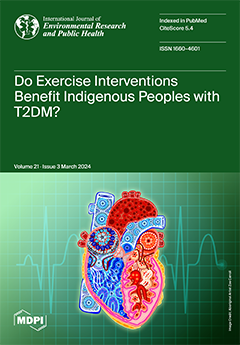This study compared physiological responses to two work/rest cycles of a 2:1 work-to-rest ratio in a hot environment. In a randomized crossover design, fourteen participants completed 120 min of walking and rest in the heat (36.3 ± 0.6 °C, 30.2 ± 4.0% relative
[...] Read more.
This study compared physiological responses to two work/rest cycles of a 2:1 work-to-rest ratio in a hot environment. In a randomized crossover design, fourteen participants completed 120 min of walking and rest in the heat (36.3 ± 0.6 °C, 30.2 ± 4.0% relative humidity). Work/rest cycles were (1) 40 min work/20 min rest [40/20], or (2) 20 min work/10 min rest [20/10], both completing identical work. Core temperature (T
c), skin temperature (T
sk), heart rate (HR), nude body mass, and perception of work were collected. Comparisons were made between trials at equal durations of work using three-way mixed model ANOVA. T
c plateaued in [20/10] during the second hour of work (
p = 0.93), while T
c increased in [40/20] (
p < 0.01). There was no difference in maximum T
c ([40/20]: 38.08 ± 0.35 °C, [20/10]: 37.99 ± 0.27 °C,
p = 0.22) or end-of-work T
sk ([40/20]: 36.1 ± 0.8 °C, [20/10]: 36.0 ± 0.7 °C,
p = 0.45). End-of-work HR was greater in [40/20] (145 ± 25 b·min
−1) compared to [20/10] (141 ± 27 b·min
−1,
p = 0.04). Shorter work/rest cycles caused a plateau in T
c while longer work/rest cycles resulted in a continued increase in T
c throughout the work, indicating that either work structure could be used during shorter work tasks, while work greater than 2 h in duration may benefit from shorter work/rest cycles to mitigate hyperthermia.
Full article





